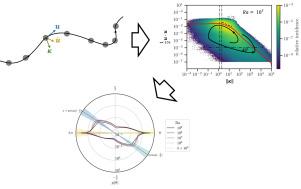基于曲率的能量谱揭示了瑞利-巴姆纳德对流流态的变化
IF 2.5
3区 工程技术
Q2 MECHANICS
引用次数: 0
摘要
我们使用由速度矢量场或粒子轨迹导出的局部曲率作为结构尺寸的替代品来计算基于曲率的能谱。对均匀各向同性湍流的应用表明,这些光谱复制了经典能谱的某些特征,如惯性范围向泰勒微尺度等效曲率延伸的斜率。由于这种基于曲率的分析框架是基于采样的,它还允许对所考虑的动能和曲率的时间演变进行进一步的统计分析。这些分析的主要发现是,惯性范围的斜率也出现在包含两个时间演化分量的矢量角度的概率密度分布中。这种密度分布进一步表现出随瑞利数而变化的形状特征。这种瑞利数的演变可以观察到在瑞利数106和107之间流动形式的变化。通过有条件地对显著的时间演化行为进行采样,并将其投射回物理空间,可以对这种制度变化进行深入了解。具体表现为不同时间演化行为的空间分布变化。最后,我们证明了这种分析可以应用于测量的拉格朗日粒子轨迹。本文章由计算机程序翻译,如有差异,请以英文原文为准。

Curvature-based energy spectra revealing flow regime changes in Rayleigh–Bénard convection
We use the local curvature derived from velocity vector fields or particle tracks as a surrogate for structure size to compute curvature-based energy spectra. An application to homogeneous isotropic turbulence shows that these spectra replicate certain features of classical energy spectra such as the slope of the inertial range extending towards the equivalent curvature of the Taylor microscale. As this curvature-based analysis framework is sampling based, it also allows further statistical analyses of the time evolution of the kinetic energies and curvatures considered. The main findings of these analyses are that the slope for the inertial range also appears as a salient point in the probability density distribution of the angle of the vector comprising the two time evolution components. This density distribution further exhibits changing features of its shape depending on the Rayleigh number. This Rayleigh number evolution allows to observe a change in the flow regime between the Rayleigh numbers and . Insight into this regime change is gathered by conditionally sampling the salient time evolution behaviours and projecting them back into physical space. Concretely, the regime change is manifested by a change in the spatial distribution for the different time evolution behaviours. Finally, we show that this analysis can be applied to measured Lagrangian particle tracks.
求助全文
通过发布文献求助,成功后即可免费获取论文全文。
去求助
来源期刊
CiteScore
5.90
自引率
3.80%
发文量
127
审稿时长
58 days
期刊介绍:
The European Journal of Mechanics - B/Fluids publishes papers in all fields of fluid mechanics. Although investigations in well-established areas are within the scope of the journal, recent developments and innovative ideas are particularly welcome. Theoretical, computational and experimental papers are equally welcome. Mathematical methods, be they deterministic or stochastic, analytical or numerical, will be accepted provided they serve to clarify some identifiable problems in fluid mechanics, and provided the significance of results is explained. Similarly, experimental papers must add physical insight in to the understanding of fluid mechanics.

 求助内容:
求助内容: 应助结果提醒方式:
应助结果提醒方式:


